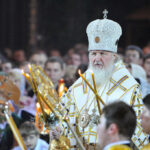Published July 12, 2012
Cracow—Somewhere on the far side of what Tom Wolfe called the Halusian Gulp, Father Francis X. Murphy, C.Ss.R., is reading the July 11 Washington Post and groaning—if, that is, his purgatorial purification has been effective.
For it was Father Murphy who, covering the Second Vatican Council for The New Yorker under the pseudonym “Xavier Rynne,” concocted the cowboys-and-Indians hermeneutic of all things Catholic that has plagued the mainstream media’s reporting and commentary on the Catholic Church for two generations: There are good-guy Catholics, known as “liberals” or “progressives,” who want to make the Church relevant to contemporary society and culture; and there are bad-guy Catholics, known as “conservatives” or “traditionalists,” who want to retreat into catacombs of intransigence because of their inability to grasp or comprehend a modern (and, latterly, postmodern) world they regard with horror.
Now, to be sure, a writer like Murphy, trying to explain the 21st ecumenical council in history to the generally secularized readership of The New Yorker, had a problem on his hands. How could even a gifted and witty scribe (which Murphy/Rynne was) explain, let alone make exciting, arcane debates over doctrine, often conducted in a strange vocabulary, for people who regarded “doctrine” as a synonym for “mindlessness” and “intellectual immaturity,” and in a culture where pragmatism and “technique” had conquered all? Murphy/Rynne had excellent inside sources in Rome, where he had long worked; what he needed was what would now be called—cue fingernails scraping down blackboard—a “narrative.” So Murphy/Rynne hit on a brilliant strategy, perfectly adapted to the Sixties and the middle years of Kennedy Camelot: treat Vatican II as a political contest between the forces of light and the forces of reaction; run everything and everybody at the council through those filters; and then watch readers acclaim, with one voice, “I get it!”
So, beginning 50 years ago this coming October, “Xavier Rynne”/Francis X. Murphy set in analytic concrete an interpretation of the Catholic Church, its internal affairs, and its engagement with public life that is ubiquitous in the 21st-century mainstream media—and not only in the United States. Here too in Poland, the cowboys-and-Indians hermeneutic dominates the national media, although the preferred good-guy/bad-guy categories are “open Church” and “closed Church.” The same nonsense prevails throughout the rest of Europe, even as the European Catholicism that most enthusiastically embraced the “progressive” or “open Church” model shrinks into ecclesial and public inconsequence.
The problem, of course, is that the cowboys-Indians/left-right optic is incapable of grappling with the fact that the Catholic Church is about true-and-false, not liberal-and-conservative. So why its long shelf life? The tenacity of the Rynne hermeneutic is, in a way, quite understandable. In a culture in which people imagine that religious conviction is a lifestyle choice of no more intellectual or moral consequence than the choice of a pet, it takes serious effort to grasp that what the Catholic Church teaches about the nature of God or the requisites for ministerial ordination is entirely different from the choice between a schnauzer and a dachshund. And in a secularized culture in which “choice” is the one sacred word, a Church that insists that its leadership teaches authoritatively is going to be easily portrayed as ham-handed, insensitive, out of step. Yet for all that the Rynne optic on matters Catholic is a perfect fit for postmodern America (as it was a perfect fit for the Sixties), its profligate use is too often a sign of intellectual laziness—and, I would suggest, a violation of a basic journalistic canon, according to which the reporter’s first task, like the historian’s, is to understand the subject as he, she, or it understands himself, herself, or itself.
The perceptual distortions the Rynne optic inevitably creates were on full display in a story in that July 11 Post about teachers at a Catholic Sunday school in the diocese of Arlington, Va., who had resigned rather than profess that they believed, and would teach, what the Catholic Church believes and teaches. One might, at first blush, think it entirely unexceptionable that the Catholic bishop of Arlington, who has responsibility for the integrity of the Catholic “brand” in his diocese, would require that teachers in his parish schools and Sunday schools believe and teach what the Church believes and teaches. But that was not the Post‘s view of the matter. Its reporter crafted a narrative straight out of the Rynne playbook and portrayed the dispute in Arlington as one between conscience-driven laity (women, of course) and an ecclesiastical establishment dominated by authoritarian males (who had not learned the lessons of ecclesiastical acquiescence to the Nazis, no less!). That the Catholic Church has not only the right but the responsibility to ensure that what is taught in its schools is what the teaching authority of the Church teaches to be true went completely unremarked in the story.
But why should it be remarked, if all this is just a matter of choice among opinions, none of which has any greater claim to authority than another? Why not assume that “conscience” is some kind of trump card that has nothing to do with truth? Why not parse the entire Arlington situation (and thousands of others like it, over the decades) as a political struggle pitting crusty conservatives against heroic liberals?
When Rynne/Murphy created the liberals-vs.-conservatives story line of modern Catholicism in the fall of 1962, there was, it must be said, something to it. Pope John XXIII did open the Second Vatican Council on October 11, 1962, by appealing to history as the “teacher of life” and gently scolding the “prophets of gloom” who saw nothing but disaster in modernity. The early days of Vatican II were dominated by a political struggle in which entrenched curial forces committed to a specific way of doing theology and a specific understanding of the Church and its authority battled for control of the council’s agenda with bishops who had more pastoral experience and whose thinking was being shaped by theologians open to a variety of methods in Catholic theology. Echoes of that struggle, which was won by the forces Rynne portrayed (and not without reason) as the good guys, continued until the council closed on December 8, 1965.
All of that can be freely admitted. At the same time, it is also true that elements of Rynne’s “good guy” faction then went more than a bit overboard, imagining Vatican II as a council of rupture with the past—a new starting point for the Church’s self-understanding and teaching, untethered to an authoritative tradition and taking its intellectual cues, not from the Bible or the Creeds, but from the ambient public culture. And when that began to happen, some of Rynne’s good guys—including the present pope, then a theological adviser to the cardinal archbishop of Cologne, an influential council father—foresaw deep trouble and began to speak and write of Vatican II as a council that had to be understood in continuity with the past. And according to this optic, while Vatican II certainly stretched and expanded older forms of Catholic self-understanding, it did so in an organic way, developing what was already implicit in the Church’s doctrine. Vatican II did not, in other words, reinvent the Catholic Church. For the Church had no authority to reinvent the constitutional form it had been given by Christ himself, just as it had no authority to reinvent the truths that the Church had grasped over the centuries under the guidance of the Holy Spirit.
Some things, in other words, were not matters of “choice.” Some things were settled. And while the Church’s understanding of settled things could be deepened, the settled things th
emselves were not ultimately fungible.
The party of ultimate fungibility is dying in the Catholic Church. It has almost no resonance in those places where the Church is growing rapidly, like Africa. It has proven itself a pastoral failure in Europe. It has proven itself intellectually sterile throughout the developed world, where a younger generation of theologians is far more interested in exploring the Catholic tradition than deconstructing it. There is ample room in the Catholic Church for theological exploration, but in the future, that exploration is going to take place within certain boundaries; and when those boundaries are breached, the “brand” is going to be defended. This is not so much a matter of authority—as in “Who’s in charge?”—as it is a matter of doctrinal integrity, clear identity, and evangelical purpose. For both doctrinal integrity and clear identity are essential if the Catholic Church is to become the vibrant evangelical movement it must be in order to preach the Gospel effectively and form communities of decency and compassion in an increasingly hostile cultural environment.
So, as we approach the golden anniversary of the opening of Vatican II, perhaps it’s time to lay “Xavier Rynne” to rest once and for all. There are a virtual infinity of interesting Catholic stories available to inquiring journalists; virtually none of them makes sense if parsed in liberal-vs.-conservative terms. Rynne/Murphy had a good run. But the days when that optic on all things Catholic made even a modicum of sense are long past. Only the intellectually lazy or ideologically besotted will fail to recognize that—and to move beyond it, into that real engagement with history for which Blessed John XXIII rightly called.
George Weigel is Distinguished Senior Fellow of Washington’s Ethics and Public Policy Center, where he holds the William E. Simon Chair in Catholic Studies.











